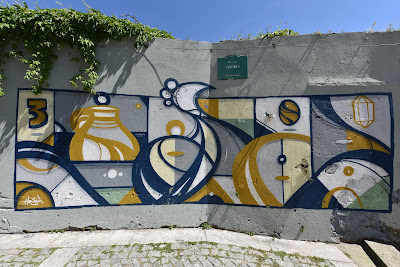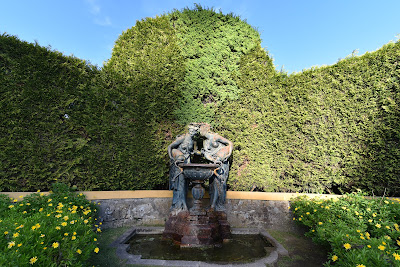Exploring Porto Portugal
Exploring Porto Portugal
Camino Portuguese
After our refreshments, we bravely set out once again into the hustle and bustle of the crowded streets of Porto. As we made our way through the steep, winding, cobblestone streets of this eclectic and ancient city, we noticed a change in the local people. As in North American cities, many people walked with their eyes cast down at mobile phones, few people exchanged friendly greetings as they passed each other, and everyone seemed to be in a hurry. It was quite a change from the friendly people and relaxed atmosphere we have been enjoying in the more rural areas of Portugal.
We slowly climbed back up to the Se do Porto Cathedral, which was built at the highest point in the city. Construction of this Cathedral, which is now a National Monument, began in the 12th century, but it has been rebuilt and renovated many times over the centuries. This has left it a hodgepodge of architectural styles, which a Baroque temple, a Romanesque nave, and a cloister and chapels done in the Gothic style. Although the nave was very beautiful, we struggled to appreciate it as a place of worship, experiencing it more like a popular tourist attraction. As we waited in a long line to pay admission to enter, we were dismayed and somewhat horrified to hear someone yelling 'Move, out of my way, I'm a pilgrim' as they tried to shove past others behind us. Once inside the building, we were somewhat swamped by very large tour groups that vied with each other for position in the rooms and narrow hallways and apologetically pushed anyone not belonging to a group out of the way.
We took some time to visit the cloister, which was marginally less crowded and somewhat more enjoyable for us. The walls of the cloister were decorated with blue and white pictorial tiles. Some of the panels depicted stories from "The Metamorphosis" and the life of Mary, while others told stories from the bible. The attention to detail in the scenes was exquisite, and looking at them made me wish I was better at understanding the stories they were telling. Apparently, the Portuguese tradition of making 'Azulejos' tiles came from the Berbers (or Moors), who arrived in Gibraltar in 711 AD from North Africa.
From the cloister, we made our way up to the roof, which offered a beautiful, panoramic view over the red roofs of Porto, the winding blue ribbon of the Duoro River, and the distant hills beyond. Already the day was getting warm, and a heat haze was beginning to swallow the horizon.
After leaving the Se Cathedral, we took the opportunity to visit the Sao Bento Railway Station, which also features some incredible tile work. The outside of the station, which was built in 1900, resembles a French chateau, but the inside is decorated with over 20,000 Azulejos tiles showing scenes from historically important events in Porto and Portugal. This station is listed as one of the top places to visit in Porto, and it also still fulfills its function as a railway station, linking Porto with Lisbon. Needless to say, it was incredibly crowded inside.
Feeling like we were ready for a breather, we headed up the Rua Santa Catarina, one of the main tourist streets in Porto. Failing to be enticed by the American shops geared towards tourists, we gratefully dived into a small cafe, where we obtained two strong coffees.
Wishing to escape the crowds, and see some of everyday Porto, we decided to wander without looking at the map or setting a destination. We made our way through many small, winding, cobblestone streets, and eventually found ourselves outside the Camara Municipal do Porto. The striking town hall buildings were constructed in the 1920's and resembled the huge communal palaces of northern Europe. The whole structure was dominated by a large clock tower.
Next, our wanderings took us to the Torres dos Clerigos Tower, which is a very tall bell tower attached to the Igreja dos Clerigos, or Church of the Clergymen. The church was built in the mid-1700s, and the tower was conceived and built a few years later. The tower is 248 ft high, making it the tallest building in Porto, and if you climb the 240 steps to reach the top, apparently you will be rewarded with a great view of the city. We discovered that we had to buy tickets to climb the tower, and then wait in line to climb up. The wait to buy a ticket was about an hour, and digital signs indicated the wait to climb the tower was another couple of hours. Feeling that there were better ways to spend our time in Porto we decided to content ourselves with visiting the church instead. This turned out to be a good decision, and we enjoyed the cooler, quieter, dark beauty of the interior.
As it was approaching noon, and we were feeling a bit peckish, we went in search of food. We decided to try something different and impulsively decided to try bolhinos de bacalhau and locally produced white port. I knew 'bacalhau' meant cod, but Sean asked if these mysterious deep-fried balls contained meat, and was told no. They didn't, but as I suspected (since often in Europe fish are not considered meat and are offered with vegetarian meals), they turned out to be cod and cheese balls. Since I don't eat fish either, Sean enjoyed both of them, and I happily enjoyed the port and consumed a small bowl of delicious gelato instead.
After this impromptu snack, we continued our wanderings, past the Museum of Justice, which was closed, and a tiny park, which felt like a small oasis of green calm in the midst of the busy city.
A short time later our wanderings took us past another place we'd hoped to visit: the famous Livraria Lello Irmao bookshop. The curved wooden staircase at the center of the shop is a major attraction and apparently was J.K. Rowling's inspiration for the moving staircases in Hogwarts School of Witchcraft and Wizardry. The ornate wooden ceiling, stained glass windows, and columns covered in bronze carvings are also impressive, as are the floor-to-ceiling bookshelves. When we walked by the lineup to get inside was over two blocks long and several people deep. Disappointed but feeling claustrophobic at the mere thought of the crowds inside, we decided to give it a miss.
Our next stop was at the Centro Portugues de Fotografia. The Museum of Photography is housed in an impressive building that was constructed in the 1700s and served as a prison. As you move through the cells inside to see the displays you walk through the old iron gates, and the windows are still covered in their thick iron bars. The museum features a collection of cameras, showcasing how they have changed over the years. A particularly interesting display showed 'hidden' cameras that were located inside mundane objects, like cigarette lighters and Coca-Cola cans. We also enjoyed an exhibition of portraits and landscape photographs by a renowned Portuguese photographer, Pedro Medeiros.
After perusing our guidebook for a bit, we decided to head out once again, this time in search of nature. Our destination, amid the extreme heat of the afternoon, was the Porto Palacio de Cristal Park and Gardens.
The Crystal Palace, which was built in the late 18th century to show off Portugal's expertise in using cast iron and glass to create a huge conservatory, is currently closed, but the gardens remain open. They feature a combination of trees, natural areas, and formally landscaped gardens, and the whole site is located on a hill, high above the city. We walked the wooded terraces, and admired the flowerbeds, statues, and fountains.
A small pond was home to a small flock of domestic chickens, peafowl were strolling freely in the gardens, and we enjoyed the sounds of songbirds in the trees. It was very peaceful, frequented by families who let their children run free, couples enjoying picnics on the expansive green lawns, and students studying while perched on terraces with a view over the city. It felt like we had finally found a spot slightly off the beaten track. We spent a wonderful spring evening strolling along the treed pathways, looking out through the line of palms over the city and river below, and relaxing.
On the way back to our rooms we walked through the university, and then down a steep street leading down to the Duoro River. This was our first taste of the Porto which is not on display for tourists, and it was charming, appealing, and far less crowded. On the way back to our rooms we stopped at the Cafe Rio, a small restaurant at the bottom of a hotel. Stopping at a place with an English menu felt like a cop-out, but we were tired and very hungry and didn't want to head out in the morning on an empty stomach if we failed to find vegetarian food in a more traditional restaurant. After enjoying a mushroom omelette, salad, and chocolate mousse we felt much revived.
Our experiences today left us feeling like Porto had a lot to offer, but we had somehow failed to find it. One of the lessons we've learned on our Caminos is that some places seem to click, and everything goes well, while others just don't seem to work out. The shabbiest, most depressing-looking places can be the source of wonderful memories, if you find yourself in good company, experience a random act of kindness, or enjoy a delicious meal. Beautiful, romantic, and opulent places can seem completely unappealing if you experience rudeness, ignorance, misunderstanding, loneliness, or fail to find food. Somehow Porto just didn't click for us. It is a beautiful, colourful, and romantic city, but we failed to find our way past the crowds, rudeness, and noise to the magic beneath. Perhaps one day we will return, and have a different experience.
Accommodation: By the River Guesthouse










































































Comments
Post a Comment